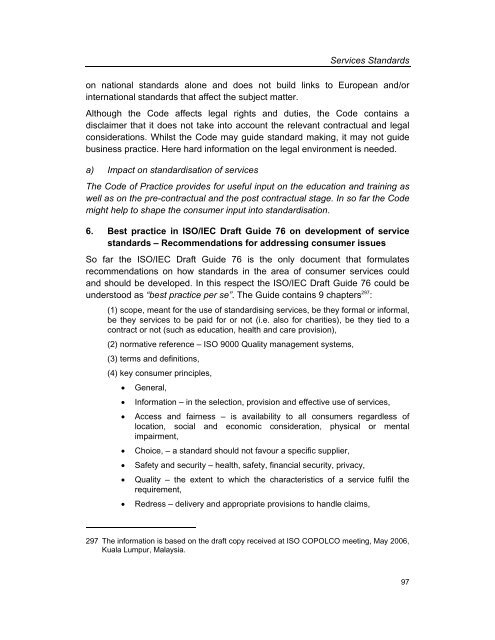Services Standards: Defining the Core Consumer Elements ... - ANEC
Services Standards: Defining the Core Consumer Elements ... - ANEC
Services Standards: Defining the Core Consumer Elements ... - ANEC
You also want an ePaper? Increase the reach of your titles
YUMPU automatically turns print PDFs into web optimized ePapers that Google loves.
<strong>Services</strong> <strong>Standards</strong><br />
on national standards alone and does not build links to European and/or<br />
international standards that affect <strong>the</strong> subject matter.<br />
Although <strong>the</strong> Code affects legal rights and duties, <strong>the</strong> Code contains a<br />
disclaimer that it does not take into account <strong>the</strong> relevant contractual and legal<br />
considerations. Whilst <strong>the</strong> Code may guide standard making, it may not guide<br />
business practice. Here hard information on <strong>the</strong> legal environment is needed.<br />
a) Impact on standardisation of services<br />
The Code of Practice provides for useful input on <strong>the</strong> education and training as<br />
well as on <strong>the</strong> pre-contractual and <strong>the</strong> post contractual stage. In so far <strong>the</strong> Code<br />
might help to shape <strong>the</strong> consumer input into standardisation.<br />
6. Best practice in ISO/IEC Draft Guide 76 on development of service<br />
standards – Recommendations for addressing consumer issues<br />
So far <strong>the</strong> ISO/IEC Draft Guide 76 is <strong>the</strong> only document that formulates<br />
recommendations on how standards in <strong>the</strong> area of consumer services could<br />
and should be developed. In this respect <strong>the</strong> ISO/IEC Draft Guide 76 could be<br />
understood as “best practice per se”. The Guide contains 9 chapters 297 :<br />
(1) scope, meant for <strong>the</strong> use of standardising services, be <strong>the</strong>y formal or informal,<br />
be <strong>the</strong>y services to be paid for or not (i.e. also for charities), be <strong>the</strong>y tied to a<br />
contract or not (such as education, health and care provision),<br />
(2) normative reference – ISO 9000 Quality management systems,<br />
(3) terms and definitions,<br />
(4) key consumer principles,<br />
• General,<br />
• Information – in <strong>the</strong> selection, provision and effective use of services,<br />
• Access and fairness – is availability to all consumers regardless of<br />
location, social and economic consideration, physical or mental<br />
impairment,<br />
• Choice, – a standard should not favour a specific supplier,<br />
• Safety and security – health, safety, financial security, privacy,<br />
• Quality – <strong>the</strong> extent to which <strong>the</strong> characteristics of a service fulfil <strong>the</strong><br />
requirement,<br />
• Redress – delivery and appropriate provisions to handle claims,<br />
297 The information is based on <strong>the</strong> draft copy received at ISO COPOLCO meeting, May 2006,<br />
Kuala Lumpur, Malaysia.<br />
97
















